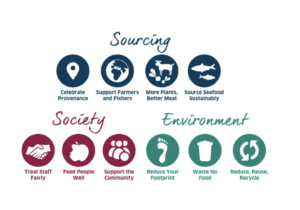Ann Arbor’s Example:
BLØM is an independent meadery based in Ann Arbor that specializes in mead—a type of wine made from honey. BLØM is deeply committed to sustainability. For example, they prioritize sourcing honey and other ingredients from within Michigan whenever possible. During the construction of their meadery, they opted for durable, reusable materials such as glassware and ceramic plates to minimize waste. Their sustainability efforts also extend to utility management: they reduce HVAC use during non-public hours and have invested in large-format stainless steel tanks that require less frequent cleaning. Despite these sustainability commitments, or perhaps because of them, BLØM remains profitable.
Shari’s Cafe & Pies offers another real-world example of sustainable restaurant practices in the U.S. As the largest full-service restaurant chain in the Pacific Northwest, they operate 24/7 in 100 locations across six states. Shari’s has taken significant steps to reduce energy use by retrofitting gas boilers, installing automatic door closers and LED lighting, deploying heated dipper wells, and incorporating demand-controlled ventilation systems in their kitchens. They’ve also invested in energy-efficient equipment and management systems. As a result, the company has cut gas usage by over 7%, reduced waste by 19%, and achieved water savings of more than 37% compared to its 2012 baseline—all while lowering electricity and water costs.
While Shari’s is not an independently owned business, its success with sustainable HVAC and utility systems offers valuable lessons that locally owned Ann Arbor restaurants can learn from.




